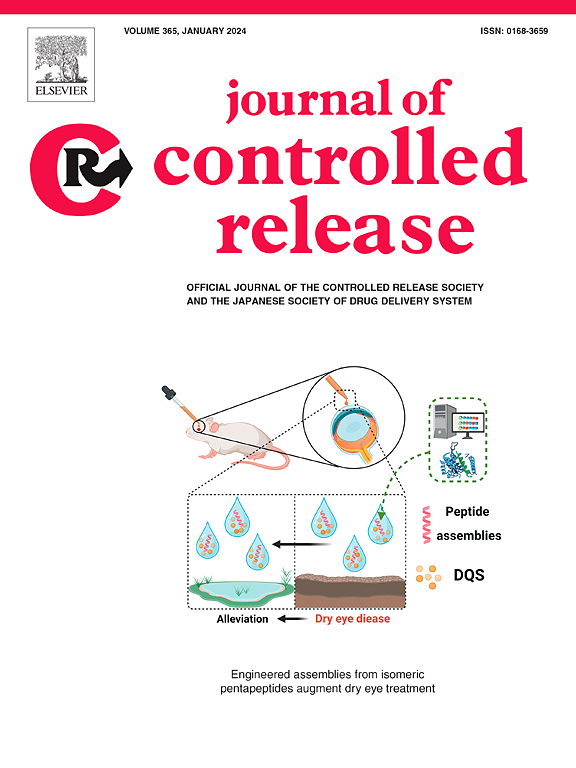Dual-barrier traversing liposomes with ROS-responsive rigidity tuning for oral ischemic stroke therapy
IF 10.5
1区 医学
Q1 CHEMISTRY, MULTIDISCIPLINARY
引用次数: 0
Abstract
For sustained ischemic stroke intervention, oral delivery remains optimal. However, conventional nanocarriers like liposomes fail to overcome both the intestinal epithelial (IEB) and blood-brain barriers (BBB). We engineered dual-functional, butylphthalide (NBP)-loaded liposomes (C-NBP Lip) via amphiphilic cytidine-lipoic acid conjugate (LA-C) functionalization, establishing the first unified nanoplatform for nucleoside transporter-mediated targeting and reactive oxygen species (ROS)-responsive membrane modulation. Our strategy exploits cytidine's dual affinity for apical concentrative (CNT1) and basolateral equilibrative (ENT1) nucleoside transporters on gut epithelia, enabling efficient intestinal translocation and subsequent ENT1-mediated BBB transcytosis via a single ligand. Crucially, hydrophobic interactions between LA-C's dithiolane ring and phospholipids dynamically tuned membrane rigidity of C-NBP Lip. enabling ROS-triggered drug release at ischemic lesions. In rats, C-NBP Lip exhibited 44.61 % oral bioavailability, 137 % higher than free NBP (18.80 %), and demonstrated robust neuroprotection without toxicity in both short- and long-term rat ischemic stroke model. This work pioneers “barrier-adaptive liposomes” that integrate endogenous transporter exploitation with stimulus-responsive membrane engineering for transformative oral brain delivery.


双屏障穿越脂质体与ros反应刚性调节口服缺血性脑卒中治疗
对于持续的缺血性卒中干预,口服给药仍然是最佳的。然而,传统的纳米载体如脂质体不能同时克服肠上皮(IEB)和血脑屏障(BBB)。我们通过两亲性胞苷-硫辛酸偶联(LA-C)功能化设计了双功能负载丁苯酞(NBP)脂质体(C-NBP Lip),建立了核苷转运体介导的靶向和活性氧(ROS)响应膜调节的第一个统一纳米平台。我们的策略利用胞苷对肠上皮上的根尖浓缩(CNT1)和基底外侧平衡(ENT1)核苷转运体的双重亲和力,通过单一配体实现有效的肠易位和随后的ENT1介导的血脑屏障转运。关键是,LA-C的二硫烷环和磷脂之间的疏水相互作用动态地调节了C-NBP Lip的膜刚度。使ros触发的药物在缺血病变处释放。在大鼠中,C-NBP Lip具有44.61 %的口服生物利用度,比游离NBP(18.80 %)高137 %,并且在短期和长期大鼠缺血性卒中模型中均表现出强大的神经保护作用而无毒性。这项工作开创了“屏障适应性脂质体”,将内源性转运蛋白利用与刺激反应性膜工程结合起来,用于变革性口服脑递送。
本文章由计算机程序翻译,如有差异,请以英文原文为准。
求助全文
约1分钟内获得全文
求助全文
来源期刊

Journal of Controlled Release
医学-化学综合
CiteScore
18.50
自引率
5.60%
发文量
700
审稿时长
39 days
期刊介绍:
The Journal of Controlled Release (JCR) proudly serves as the Official Journal of the Controlled Release Society and the Japan Society of Drug Delivery System.
Dedicated to the broad field of delivery science and technology, JCR publishes high-quality research articles covering drug delivery systems and all facets of formulations. This includes the physicochemical and biological properties of drugs, design and characterization of dosage forms, release mechanisms, in vivo testing, and formulation research and development across pharmaceutical, diagnostic, agricultural, environmental, cosmetic, and food industries.
Priority is given to manuscripts that contribute to the fundamental understanding of principles or demonstrate the advantages of novel technologies in terms of safety and efficacy over current clinical standards. JCR strives to be a leading platform for advancements in delivery science and technology.
 求助内容:
求助内容: 应助结果提醒方式:
应助结果提醒方式:


